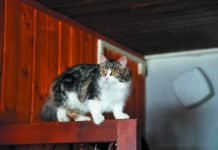I see about one cat for every 10 to 15 dogs,” says the head of the Tufts Animal Behavior Clinic, Stephanie Borns-Weil, DVM.
Why is it that people with dogs are more apt to seek professional help for their pet’s behavioral problems than people with cats? It’s because those who care for cats often do not recognize abnormal behavior for what it is, the doctor posits.
“Dogs are brought to behavior clinics because their behavior problems become someone else’s problem,” Dr. Borns-Weil says. “They’re biting people or ripping windows out of window frames because of separation anxiety, or vocalizing so much that neighbors end up complaining.” They also go outside, she adds, which increases the chances for behaviors that could resonate negatively.
But cats, who mostly live indoors and who don’t make a lot of problems for people, have behavioral problems that tend to slide under the radar. For instance, the doctor says, “it’s easy not to notice that all your cat does is hide even though that’s a sign that something is wrong. And if you do notice, it’s easy to consider it normal because it’s so common. But common behavior is not necessarily normal behavior. It’s very, very rare that I ever get anybody bringing their cat to me saying, ‘My cat never wants to come out.’”
Compounding the difficulty of pinpointing a behavior problem is that cats often make themselves scarce if they don’t feel well. So sometimes you have to distinguish a behavior problem from a medical condition.
To make it easier to tell if your cat is behaving abnormally and needs help, Dr. Borns-Weil describes three categories of problem feline behavior that people often overlook.
Hiding all the time. This one is particularly difficult because a cat’s solution for so many different kinds of problems is to hide. Once you rule out a medical issue (arthritis in particular is “seriously under-diagnosed in cats” and will often leave them staying more and more under the bed, Dr. Borns-Weil says), it’s important to work backwards to try to figure out what in the environment has led the cat to keep almost completely out of sight.
Is it that you’ve brought home a new dog? “You’d be surprised how many times people come in and say, ‘We’re having this problem with our dog — he barks excessively and growls when people come through the door,’” Dr. Borns-Weil reports. “Then, when I ask what else is going on they say, ‘Oh, yeah, the dog chases the cat.’ That means that when everybody gathers in the family room after dinner, the dog is lying around with the rest of the household, and the cat’s gone even though she used to hang around with everybody. She’s scared, and that’s not normal. It’s a problem behavior that needs a resolution. Most domestic cats don’t want to be entirely by themselves. It’s very sad.”
Maybe the problem is not a new dog but a new baby, or even a rearrangement of the furniture. Whatever it is, it’s important to recognize the cat’s stress and respond conscientiously with loving attention rather than just letting the pet self-isolate without paying any mind to what she might be going through.
Fielding passive aggression from another cat. A cat can be fearful of another cat in the home, and it might be hard to pick up on because “cats are really, really good at passive aggression,” Dr. Borns-Weil says. “It doesn’t have to be frank fighting.”
For instance, the aggressor cat might simply stare at the other one until she gets off the window seat or block her path by taking up space that he knows the other would like to cross. Such subtle forms of aggression can really interfere with a cat’s quality of life.
It’s a change in the cowed cat’s demeanor in particular that could tip people off, the doctor points out. If the cat was always social and relaxed but now keeps to herself instead of coming to the center of the action while the other cat continues to hang out in the home’s social spaces, something may have happened between the two of them that shifted the equilibrium away from harmonious coexistence.
The solution isn’t to punish the aggressor cat by giving him short shrift in favor of the scared one. It’s to duplicate resources — install more window seats, more litterboxes, more toys and games, more attention for both. That should help the aggressor cat dial it back and give the nervous cat a little more confidence. They will be able to stay out of each other’s space more as they adjust to the “atmosphere of plenty,” as Dr. Borns-Weil calls it.
Depression. Cats do an awful lot of sleeping. Still, it’s not normal for a cat to sleep all day and all night. If she does and you have ruled out medical illness, she may be depressed. Especially if a cat was somewhat social and is now rather disengaged and not interested in playing or connecting, she could be experiencing depression.
It often comes from an under-enriched environment, Dr. Borns-Weil says. The cat may not be getting time to interact with you and receive affection from you, time to exercise and do cat-like things. On their own, cats hunt, they solve problems, they monitor their territory. It’s all part of their genetic inheritance, and it’s our job to supply outlets for our pets to allow them to scratch those itches, so to speak.
“Especially for a reasonably young cat, not having activities gets depressing, and it becomes like living in isolation,” Dr. Borns-Weil says. “It starts to look normal to have a passive, overweight cat kind of sleeping all day, but it’s not. No one can cope well with not having anything to do.”





I do subscribe to the newsletter but have not seen anything about how to deal with activities for a blind cat. She is 14 y/o and blind the last three years from retinal detachment due to high blood pressure. She is otherwise healthy and seems contented since we give her lots of love and attention but what could we do to give her a bit of a challenge to enhance her life?
I had a beloved cat who started losing her vision at about 7, and was totally blind by about 12, and lived to be 20. She was a very outgoing, fearless Siamese who went outside happily and used her ears and memory of her knowledge of our one acre to continue life. She continued to follow me everywhere and engage with whatever I was doing, and even managed to catch an occasional rodent using her other
senses.
When she was inside, I made up games and activities that she could enjoy and get involved with, based on her sense of smell and good hearing. She would chase little balls-foil and ones that had little bells inside, and skitter around after them, and if she seemed confused, I would talk her back to
understanding where she was.
I was a licensed veterinary technician for 24 years, and worked for a board certified veterinary
Ophthalmologist and we saw many dogs and cats who were losing and ultimate lost all their vision. What I learned was that most animals who lose their vision, especially when it is gradual, do very well and can have quite normal and happy lives. Accommodating their specific loss to keep them safe and engaged is just routine, and most take it right in stride, though owners are often more distressed than their pet.
You love and know your cat’s personality and what she enjoys, and a little modification of things
can enhance her quality of life more than you would think.
Best of luck,